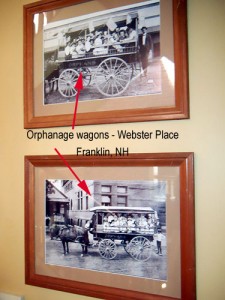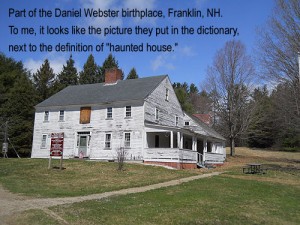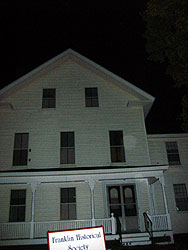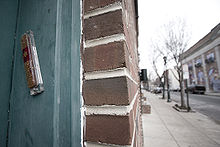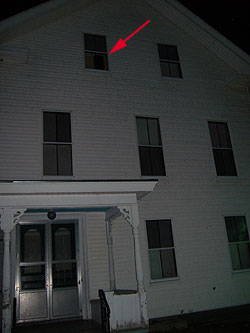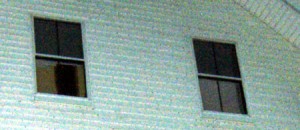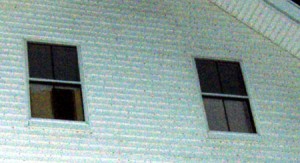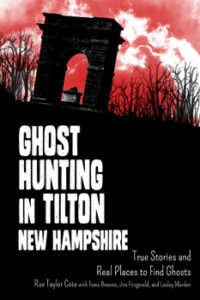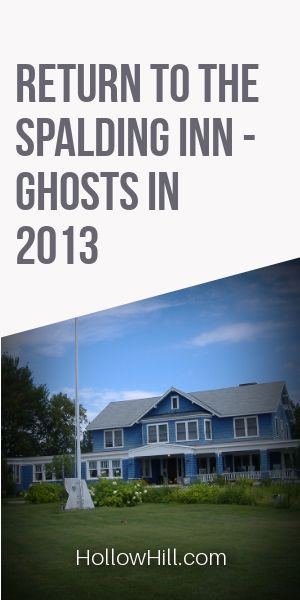 In April 2013, I visited the Spalding Inn for a ghost hunting event hosted by Jason Hawes.
In April 2013, I visited the Spalding Inn for a ghost hunting event hosted by Jason Hawes.
It had been about two years since I’d last investigated the hotel.
Frankly, my earliest overnight visit to the hotel – in 2008, before the hotel opened – was alarming.
Whatever I encountered there, it wasn’t just ghosts.
I’m in my comfort zone with ghostly phenomena.
BUT… when weird things happen, I get anxious.
So, I generally visited Jason & Grant and their families during the daytime.
I liked sitting on the hotel porch, laughing and chatting about our adventures.
Then, in 2013, I knew that my husband and I were moving soon. So, when invited, I went back to the Spalding Inn for one of Jason’s ghost hunting events.
Things had changed… really changed.
The ghostly energy confirmed what I’d discovered with my NH ley line map, shown later in this article.
But before I explain the ley line map, here’s what happened during my 2013 investigation.
My April 2013 report
The upper floor of the Spalding Inn’s carriage house seemed just as strange, but more had focused energy.
That is, many of us (including me) didn’t encounter the usual off-the-wall weird energy there.
It was… well, the word I’d use is “tidier.”
It was as if whatever’s there had a purpose for being there.
If you weren’t useful to the ghost, and whatever his or her goal was, the ghost wasn’t around.
However, some investigators experienced profound encounters and spiritual confirmations.
Those seemed to be very quirky – and somewhat conflicted – experiences.
The “hottest” areas were in and near rooms 15 and 17.
Also, the spirits (ghosts, energy, whatever) at the main level (ground floor) of the Spalding Inn’s carriage house were far more responsive to the various electronic devices in use.
Kris was eager to talk about the ghosts
During that 2013 visit, Jason Hawes’ wife, Kris, shared many stories. They were fascinating, because she was describing encounters that complemented mine.
Generally, Kris seemed more eager to talk about the hotel’s ghosts than Jason was.
But, I appreciated Jason’s decision to say less. As a high-profile ghost hunter, he needed to remain as objective as possible. Or perhaps he didn’t want to prompt visitors, but let them make their own ghostly discoveries.
What happened in 2008
I’d visited the hotel late in 2008. That was immediately after the Ghost Hunters International team investigated, but before the hotel was officially opened.
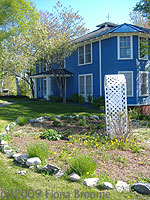 At the time, I preferred to keep a low profile. Another guest at the hotel was eager to claim the spotlight, and I was happy to let him do so.
At the time, I preferred to keep a low profile. Another guest at the hotel was eager to claim the spotlight, and I was happy to let him do so.
In general, I’m fairly shy, especially in a predominantly male setting.
Also, unless asked for details, I usually keep many of my observations to myself. I like to think about them for a few days.
That gives me time to evaluate my experiences, away from the turbulence of the hauntings.
So, I didn’t talk much about what I’d seen and felt at the hotel. It included:
-
- An apparition in the coach house
- An astonishing collection of dead flies in another room in that building
- And a voice – heard aloud – that mimicked me.
Then there was the figure that was dragging itself along the floor in the main building.
And the haunted mirror on the first floor.
And finally – back in the coach house – the completely unplugged old-school phone with the “call waiting” light blinking.
So, yes, what I’d witnessed in 2008 was very weird. I just didn’t say much about it at the time.
I may write more about this, later.
Oh, I slept soundly at the hotel. But what I witnessed during my investigations…? It was one of the strangest combination of phenomena I’ve ever encountered.
Then, Kris Hawes described what she’d seen
Five years later – in 2013 – Kris Hawes confirmed many of my experiences, without knowing about them ahead of time. After all, I’d never said much about them.
I was delighted. (And a little creeped-out, if I’m honest, especially about the unattractive figure crawling on the floor.)
As of 2013, it seemed like the ghosts were learning from visitors. The ghosts’ responses were more specific, more consistent, and involve more senses.
In other words, the Spalding Inn had become a more useful research location.
Paranormal “hot spots” at the Spalding Inn
In 2013, in the main building, the dining room felt like more of a “safe haven” from intrusive ghosts.
That was a relief. We could get away from the entities… whatever they were.
But, the perimeter of the dining room was odd. It was like walking through spiritual jello, if that makes sense.
The extended corridor (where the sleeping rooms are) was far more active than it had been.
Previously, I’d categorized most of the activity there as fae and perhaps Native American, not ghostly.
Now, several ghosts in that hallway – and sleeping rooms along it – seemed interested in contacting us.
(I’m not sure what words to use for that. Maybe those ghosts were there all along, but fairly silent. Maybe they’d migrated to that part of the hotel, where they had a bigger audience. I have no idea.)
It was time to sell the hotel
As we chatted in 2013, Kris confided that Jason and Grant were thinking of selling the hotel.
The hotel’s massive repairs had cost far more than Grant and Jason had expected. Competing with neighboring hotels – that offered more amenities for seasonal tourists – was a challenge.
And, I think Jason and Grant had started out with a different vision for the hotel.
I told Kris that selling the hotel was a good idea.
I did not tell her that – during that 2013 investigation – the energy at the hotel seemed angry.
It was a somewhat nasty, drain-everything-from-you kind of energy.
This wasn’t just a spiritual attack.
I had no doubt the malicious energy wanted to destroy the hotel’s business, crush morale, and generally tear things up.
I was happy not to spend another night there.
Why did the energy change?
Maybe the ghosts didn’t like the idea of dealing with yet another set of owners.
Or maybe the ghosts had enjoyed the attention of Jason & Grant’s ghost hunting overnights.
I’m glad Jason & Grant and their families sold the hotel. I wish the new owners very good luck with it.
And yes, I’d cheerfully return there, out of curiosity. I’d love to see if the ghosts and other entities remained there.
My northern New Hampshire ley lines map
 For the 2013 event, I’d created a special information sheet that featured ley lines at and near the Spalding Inn.
For the 2013 event, I’d created a special information sheet that featured ley lines at and near the Spalding Inn.
It also showed “hot spots” in northern New Hampshire in general.
The illustration on this page is just part of that map.
If you draw these lines on a larger map, you’ll see where they extend into other states. All locations along these lines are worth exploring.
The ghost figures indicate locations where ghosts have been reported. The star-in-circle marks indicate other paranormal reports (UFOs, etc.) and anomalies.
If you’re researching in NH, check sites on either line.
Choose the northern one if you’re interested in ghosts. Choose the southern one if you’re eager to find Bigfoot (yes, there are reports along that line) or want to see UFOs.
Two different ley lines. Two different kinds of phenomena.
The Spalding Inn is on the more ghostly line.
And, in my opinion, it’s still haunted… and perhaps by more than just ghosts.

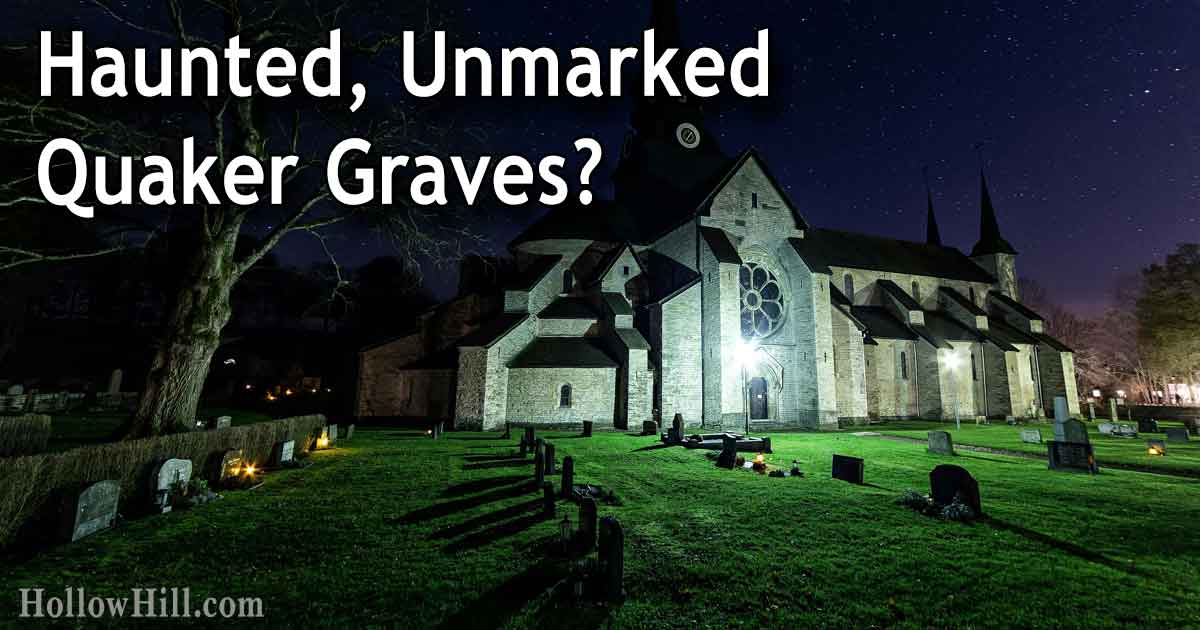
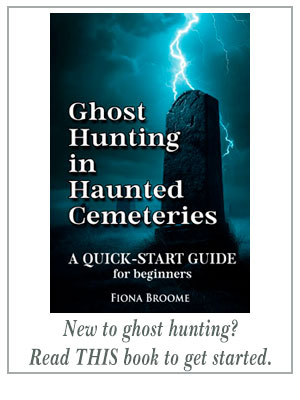
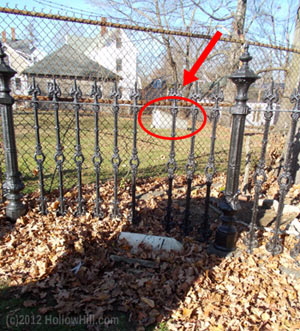 Though I’d been to Old North Cemetery before, I hadn’t noticed the odd, open field in the back of the Minot Enclosure. That field has just a few markers, and one of them reminded us of a bunker marker.
Though I’d been to Old North Cemetery before, I hadn’t noticed the odd, open field in the back of the Minot Enclosure. That field has just a few markers, and one of them reminded us of a bunker marker.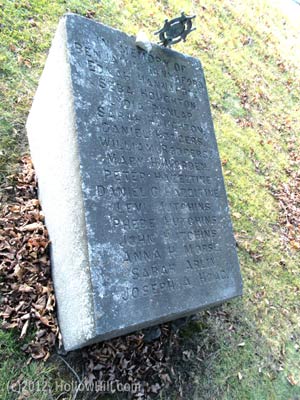 The memorial marker is on the left. (Due to the late afternoon lighting, I had to increase the contrast in this photo so that the lettering would show.)
The memorial marker is on the left. (Due to the late afternoon lighting, I had to increase the contrast in this photo so that the lettering would show.)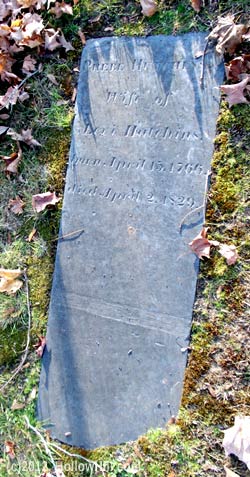 The history of the Quakers in Concord is an interesting story.
The history of the Quakers in Concord is an interesting story. According to the National Historic Register application, “The Prison Lot, comprised of a long 10′ x 75′ rectangular lot just west of lots #384 and #385 in the center of the cemetery, appears on all maps drawn after the 1844 western addition to Old North Cemetery.”
According to the National Historic Register application, “The Prison Lot, comprised of a long 10′ x 75′ rectangular lot just west of lots #384 and #385 in the center of the cemetery, appears on all maps drawn after the 1844 western addition to Old North Cemetery.”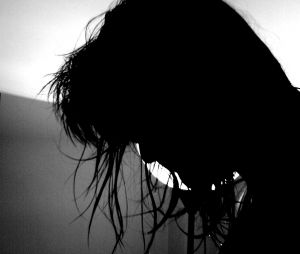 Recently, a large number of individual New Hampshire students have advised me that they’re planning to visit Vale End Cemetery (Wilton, NH) at night because they’re working on a ghost-related school project or term paper.
Recently, a large number of individual New Hampshire students have advised me that they’re planning to visit Vale End Cemetery (Wilton, NH) at night because they’re working on a ghost-related school project or term paper.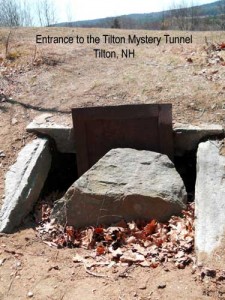 The Tilton “mystery tunnel” actually starts in Northfield, NH, not far from Exit 19 on Route 93 in New Hampshire. The entry — currently blocked with a boulder and an iron door — is off the paved path between Tilton Memorial Arch and downtown Tilton. (Walk towards town and, on the right, you may see an area where foot traffic has left a mark. The entrance to the tunnel is about 10 feet from the paved path.)
The Tilton “mystery tunnel” actually starts in Northfield, NH, not far from Exit 19 on Route 93 in New Hampshire. The entry — currently blocked with a boulder and an iron door — is off the paved path between Tilton Memorial Arch and downtown Tilton. (Walk towards town and, on the right, you may see an area where foot traffic has left a mark. The entrance to the tunnel is about 10 feet from the paved path.)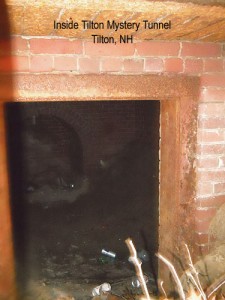 The photo on the right shows what’s immediately in back of the iron door. My camera was in the initial entry room, and — beyond it — you can see a second, large room (and sealed — or filled-in — arched passage entries) with beer cans on the dirt floor.
The photo on the right shows what’s immediately in back of the iron door. My camera was in the initial entry room, and — beyond it — you can see a second, large room (and sealed — or filled-in — arched passage entries) with beer cans on the dirt floor.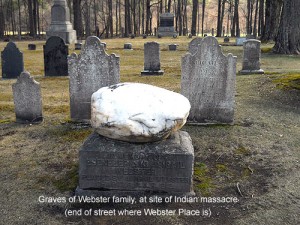 If you’re in or near Tilton and Northfield, New Hampshire, be sure to drive an extra half hour to Franklin (NH) where Webster Place has some great haunted locations. In general, you’ll visit that street during the daytime.
If you’re in or near Tilton and Northfield, New Hampshire, be sure to drive an extra half hour to Franklin (NH) where Webster Place has some great haunted locations. In general, you’ll visit that street during the daytime.